You’re not alone!
Trust me, we’ve all been there in our chainsawing adventures, wanting to slap on a longer bar! (It’s one of those things we can’t resist 🐸)
But the question is – how long of a bar you can put on your chainsaw?
Well, it depends on the power rating of your chainsaw. The more powerful a chainsaw is, the longer bar it can handle.
And for gas-powered chainsaws, it’s the engine displacement (cc) that determines the maximum length of bar you can use.
Table of Contents
ToggleChainsaw Bar Length VS CC
| Chainsaw Power Rating (cc) | Recommended Bar Length (in) |
|---|---|
| 25 cc or Less | 10-12” |
| 26-35 cc | 12-16” |
| 36-45 cc | 14-20” |
| 46-60 cc | 16-24” |
| 60-75 cc | 18-28” |
| 76-90 cc | 20-32” |
| 91-100 cc | 24-36” |
| 100-115 cc | 26-50” |
| Above 115 cc | 28-84” |
✍️ Note: The table above is for general reference only!
I’ve gone through hundreds of chainsaw manuals to verify those numbers, so you know it’s reliable!
For the most accurate info, check your chainsaw’s user manual to see what size bar you can run on your chainsaw (it’s usually written under the “Specifications”).
Can I Put an Oversized Bar on My Chainsaw?
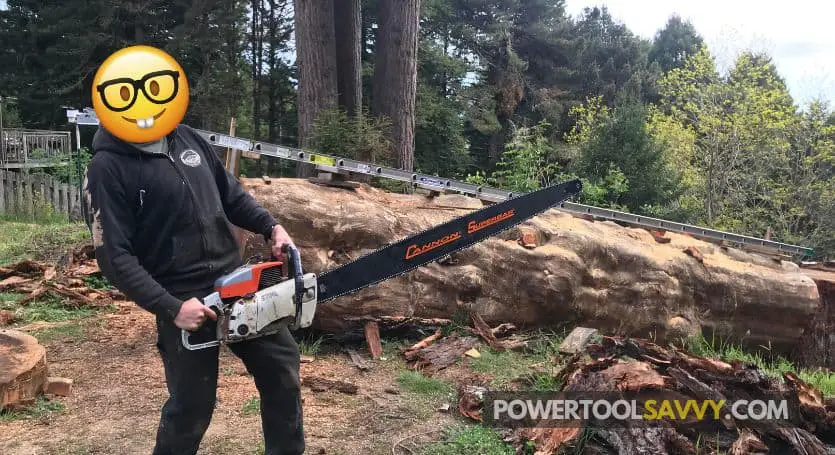
It’s not recommended at all to put an oversized bar on your chainsaw as it can lead to serious performance and SAFETY issues.
The longer the bar, the more strain it puts on the engine. This, in turn, hampers the performance of your saw and leads to overheating and problems like – 👇
- oiling issues,
- smoking,
- frequent bogging down,
- difficulty in starting,
- kickbacks,
- lack of power.
Let me make it easy for ya with an example: 👇
Say you drive a truck that has 22.5″ tires.
Now if you want to replace those tires with bigger ones (for example, 24.5″ tires), you need to first make sure that the engine is powerful enough to handle those bigger tires.
Why??
Because bigger tires mean more weight and strain on the engine. And your truck needs to be able to cope with that additional load.
The same goes here!
A 50cc chainsaw can easily handle a bar between 16″ to 20″.
But if you put a longer bar like 24″ or 28″, then it’s just too much for the saw. (It won’t be a pleasant experience!)
So, if your saw is designed to run a 16”-20” bar, it’s BEST to stick with that!
And if you’re wondering, here’s the longest chainsaw bar on the market!
How to Choose the Right Bar Length for a Chainsaw?
I hope now it’s clear to you why bar length is so important!
But still, how do you know what’s the ideal bar length for your chainsaw?
Well, it’s not that complicated!
Here’re a few factors you should consider while choosing the bar length: 👇
1. The Power of Your Chainsaw
I’m repeating it again, “The more power your chainsaw has, the longer bar length it can handle.“
That’s why, every saw comes with a recommended bar length based on its power, which is usually listed in its user manual.
Open up your saw’s user manual and head to the “Specifications” or “Technical Data” section to find the recommended bar length for your chainsaw!
(here’s an example for the Craftop NT460: 18”-24” 👇)
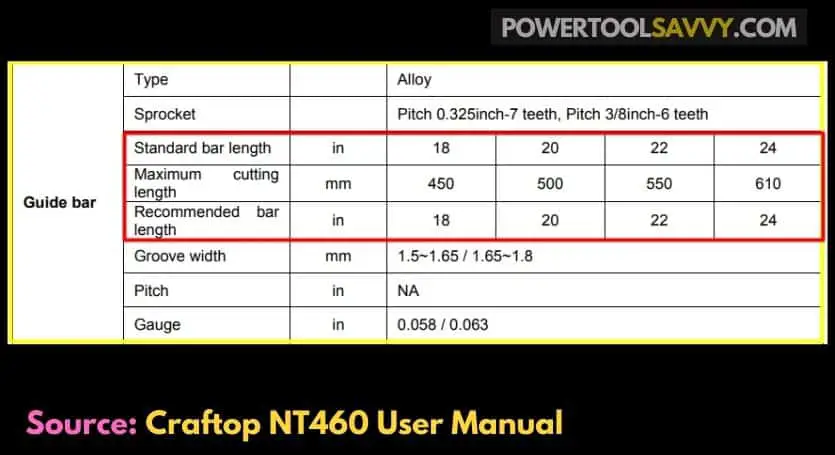
2. Softwood VS Hardwood
The type of wood you cut also makes a huge difference!
If you mostly cut hardwood like oak or maple, I would recommend sticking to a shorter bar.
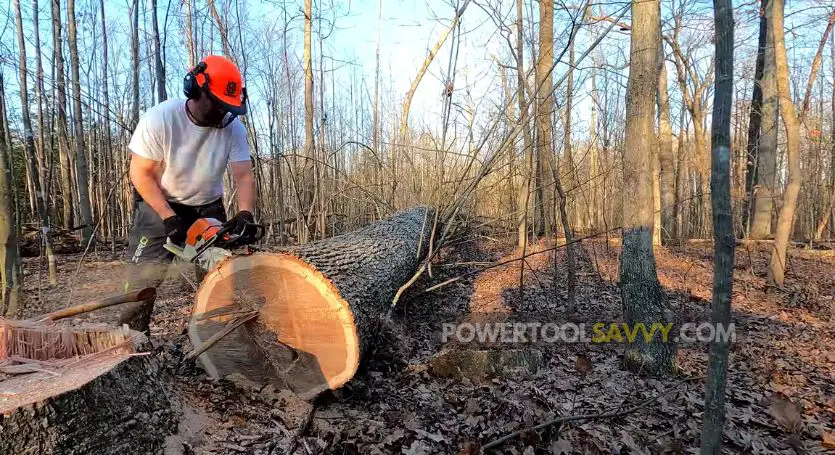
Because cutting hardwood requires more power. And as you’ve just learned, the longer the bar, the less efficient your saw becomes.
I own a Stihl MS-261. It’s a 50cc beast that can easily run a 20-inch bar with NO performance issues. But I’ve always used an 18″ bar on it.
Cause here in Ohio, I mostly cut hardwood and I don’t want to trade off power for length. 😎
If I ever need to use a longer bar, I would get a bigger saw (like a 55cc or 60cc model) to compensate for the loss of power.
On the other hand, if you cut softwood like pine or fir, you can go for a slightly longer bar.
These types of wood are easier to cut and don’t require as much power. So, putting a longer bar won’t be an issue.
3. Balance & Maneuverability
Next up is balance & maneuverability.
We all want a chainsaw that feels good in the hand and is easy to maneuver.
But here’s the truth: 👇
As you increase the bar length, the saw gets heavier and harder to maneuver.
For example, a 32″ bar could add up to 5 lbs to the overall weight of your saw (which is quite a lot!).
Here’s the chainsaw bar length to weight chart to illustrate my point: 👇
| Bar Length | Added Weight |
|---|---|
| 16" | 1-1.5 lbs |
| 18" | 2-2.5 lbs |
| 20" | 2.5-3 lbs |
| 24" | 3-3.5 lbs |
| 28" | 3-4 lbs |
| 32" | 3.5-5 lbs |
| 34" | 4-5.5 lbs |
So, if you want to achieve maximum maneuverability, I’d suggest sticking to a shorter bar (no more than 24″).
4. Reach
Do you want to cut those pesky logs without bending over?
You’ll need a slightly longer bar!
The longer the bar, the easier it is for you to reach those far-away logs and branches.
Instead of having to move around like a madman, you can just stand in one spot and cut the log from there. 🌳 🪓
This not only reduces the strain on your back but also makes it easier to cut for a longer period of time. ⏱️
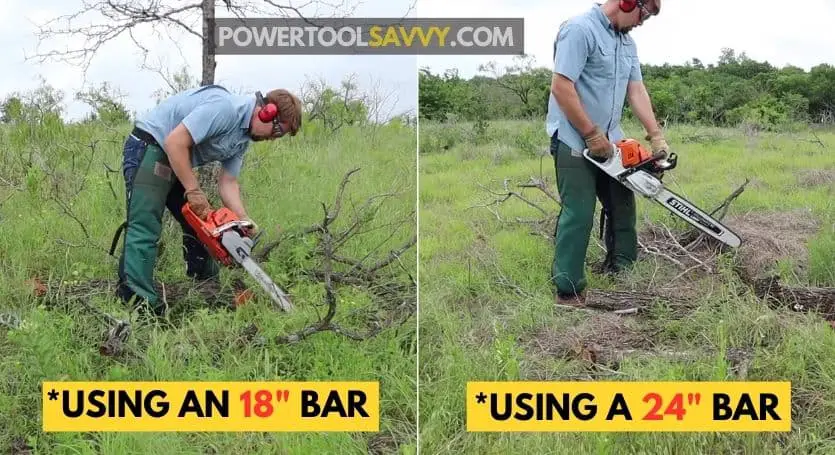
When I was 21, I used to work at a sawmill in Oregon. I suffered a nasty backache for months because of the excessive bending I had to do with my short bar. 😣
Later on, I switched to a 24″ bar. I can’t tell you how much of a relief it was to me! 🙌
5. Cost
It’s no wonder!
The longer the bar, the more it’ll cost you.
For example, an 18″ Oregon bar will cost you around $55 while a 24″ one can set you back by $65 or more. 💸
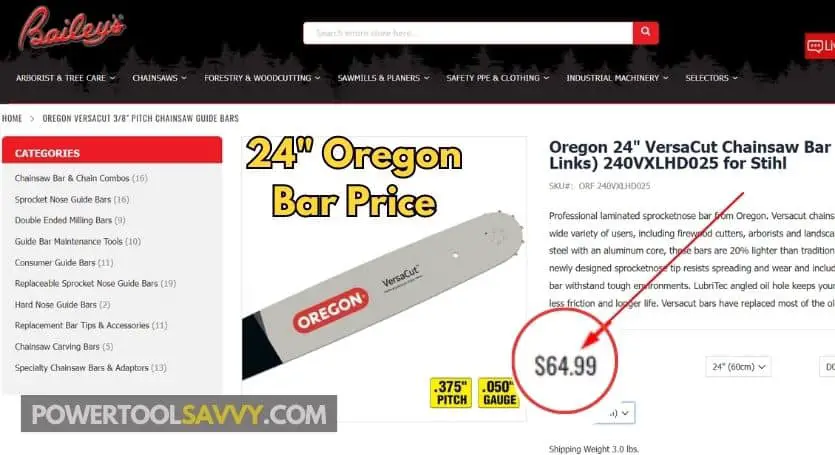
Wait, there’s more!
You’ll also need to get a longer replacement chain that fits the new bar. And that too will cost you a good amount of money! 🤑
Related Article: 👇
So before you go and make the purchase, calculate your budget accordingly.
How to Measure a Chainsaw Bar?
Do you know the length of your chainsaw bar?
No worries!
Here are 2 easy methods to figure it out: 👇
Method 1: Look for Markings on the Bar
If you pay close attention 👀, you’ll notice that almost all chainsaw bars have markings engraved/printed on them. They can be anywhere from the middle to the end of the bar.
These markings usually display the length of the bar, along with some other important details like pitch and gauge.
Don’t get confused!
The length is expressed in inches/cm (like 18″/45cm, 20″/50cm, etc) and usually written in large letters. (here’s an example 👇)
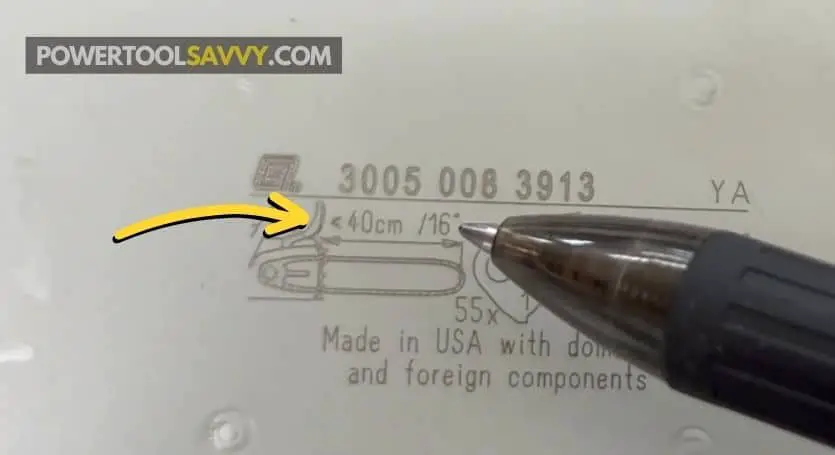
Method 2: Measure It Yourself
In case your bar doesn’t have any markings, or you just want to be sure, you can measure it yourself with a measuring tape.
Here’s the step-by-step guide to measuring a chainsaw bar: 👇
- Grab a measuring tape.
- Now start measuring from the tip of the bar all the way to the point where it meets the chainsaw body (power head).
- Make sure you’re measuring it along its middle portion. This is the longest part of the bar and will give you a more accurate measurement.
- You might get an odd number, like 17.5 inches (for example). Just round it off to the nearest even number – 18 in this case. Because chainsaw bars are usually available in only whole-number sizes (14″, 16″, 20″, 24″).
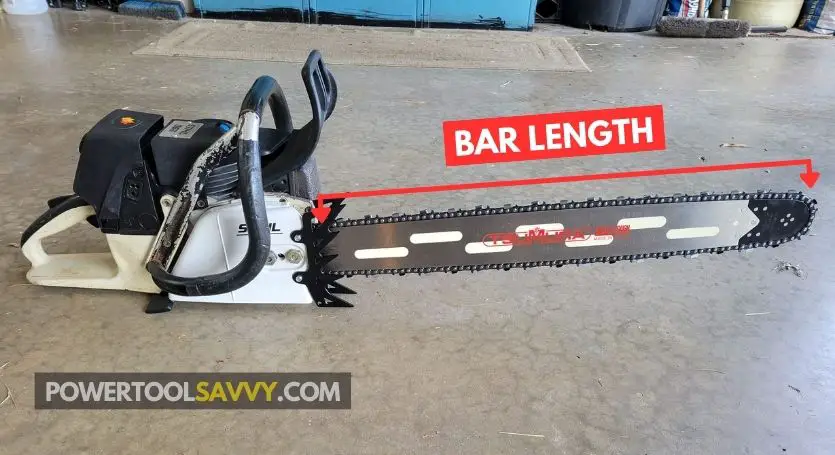
And that’s how you measure the length of a chainsaw bar. Easy, right?
“But how to measure a bar that’s off the saw?“
The process is almost the same. Just measure the bar from the tip to the center slot (where it meets the drive sprocket) and round off to the nearest even integer.
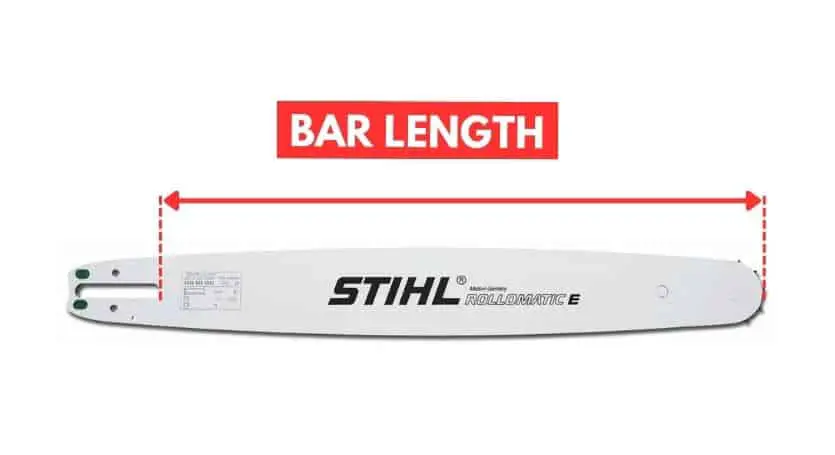
Learn More: How to Measure a Chainsaw Bar Length?
✍️ Note: Some Stihl bars don’t follow the “cutting length” rule. They’re measured from the tip to the end of the bar, which may give you a different result.
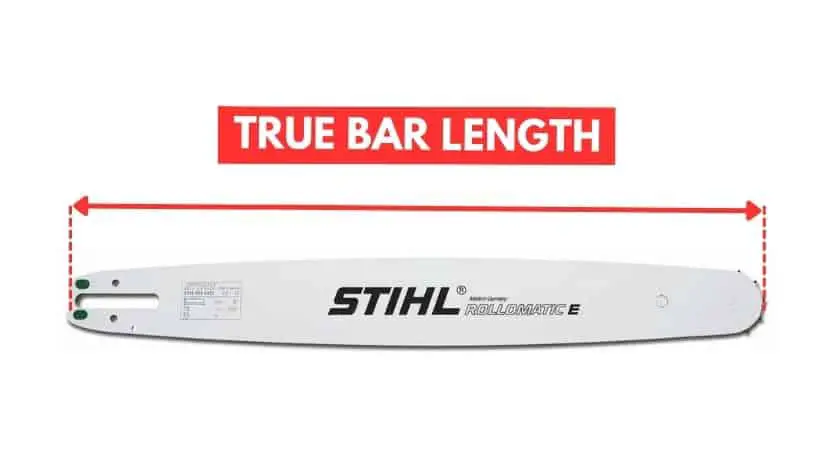
So make sure to check the manual on manufacturer’s website for specific bar length details.
Longer VS Shorter Chainsaw Bars
Say you’ve got a 60cc chainsaw. And according to the table above, you can put a bar between 16″-24″ bar on your chainsaw.
Now, what would you prefer – opting for a longer one or a shorter one?
Frankly speaking, both have their own advantages and disadvantages.
Longer Chainsaw Bars (24" or Above)
Benefits:
- ✅ Less bending while cutting
- ✅ Extended reach
- ✅ Increased cutting efficiency
Drawbacks:
- ❌ Reduced power
- ❌ Increased weight
- ❌ Longer bars are expensive
- ❌ Greater safety concerns
- ❌ Oiling issues
(Read this article where I’ve gone through all the benefits and drawbacks of longer chainsaw bars in detail: 👉 Can I Put a Longer Bar on My Chainsaw?)
Shorter Chainsaw Bars (Up to 24")
Benefits:
- ✅ More power
- ✅ Lightweight
- ✅ Better balance & maneuverability
- ✅ Smaller bars cost less
- ✅ Require less maintenance
- ✅ Less chance of hitting the ground
- ✅ Your saw is less likely to bog down
Drawbacks:
- ❌ More bending while cutting
- ❌ Difficulty reaching those pesky branches
- ❌ Limited cutting capacity
- ❌ Increased vibrations
- ❌ Smaller bars are more prone to Kickback
(To learn more about the benefits and drawbacks of shorter chainsaw bars, read this article: 👉 Can I Put a Shorter Bar on My Chainsaw?)
And that’s it!
Compare the benefits and drawbacks of each type, take into account your own needs, and you’ll know what size to go for.

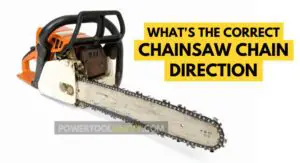

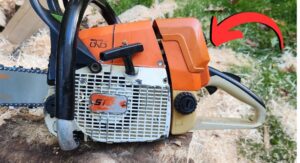


Pingback: Top Handle VS Rear Handle Chainsaw (Price, Weight, Safety)